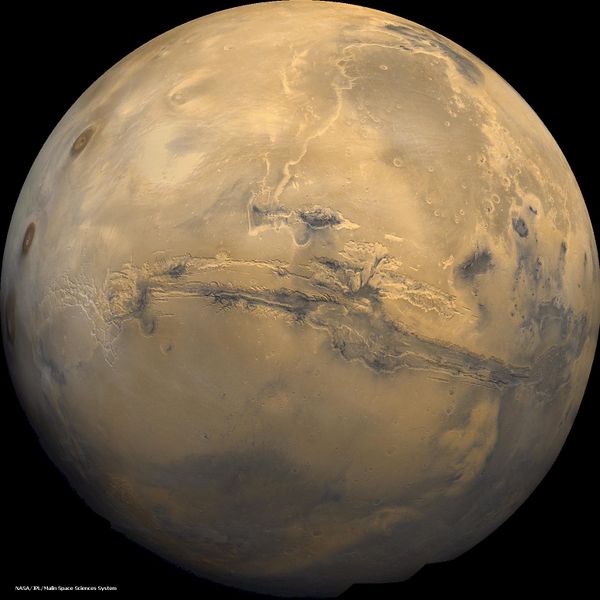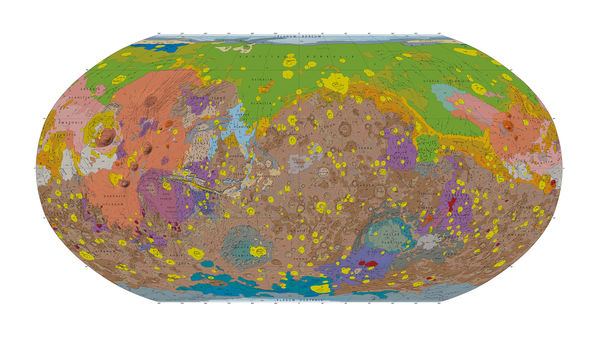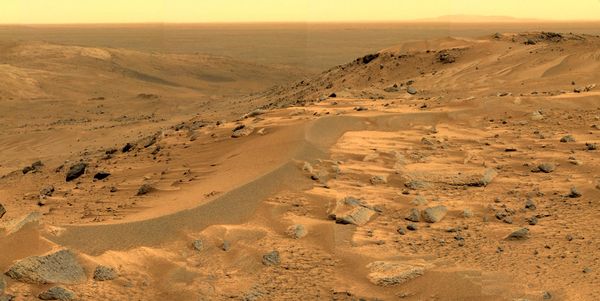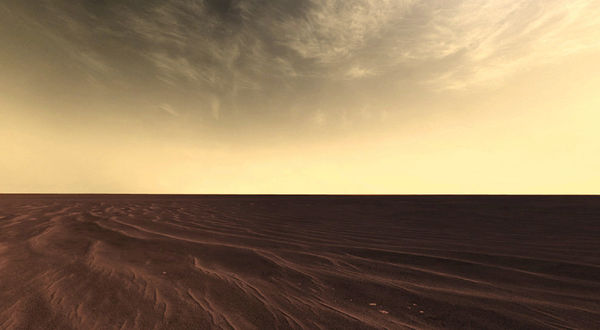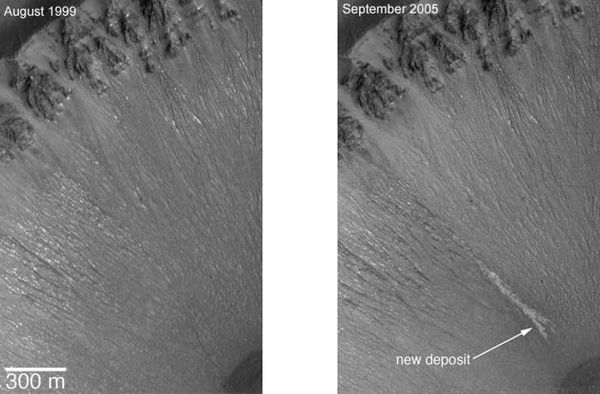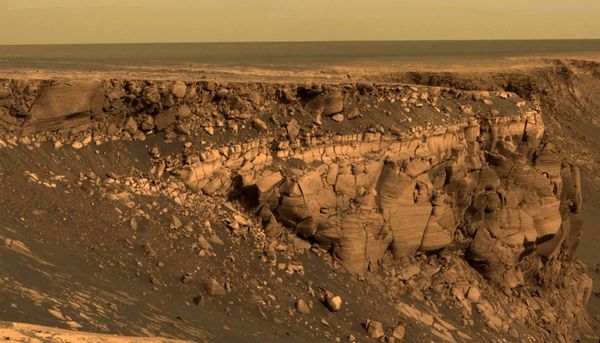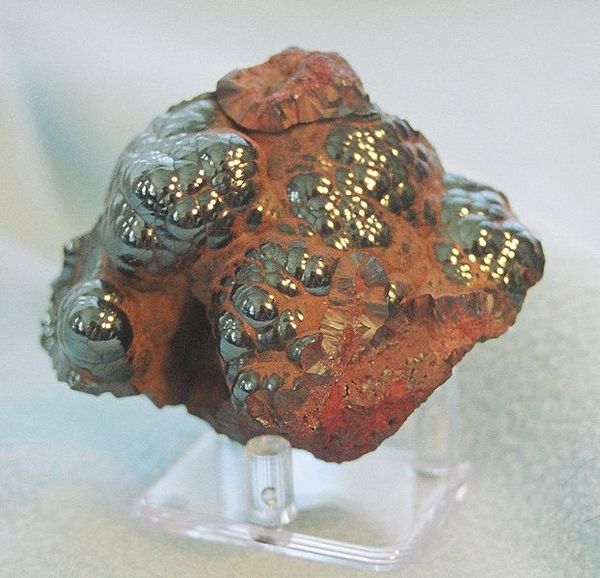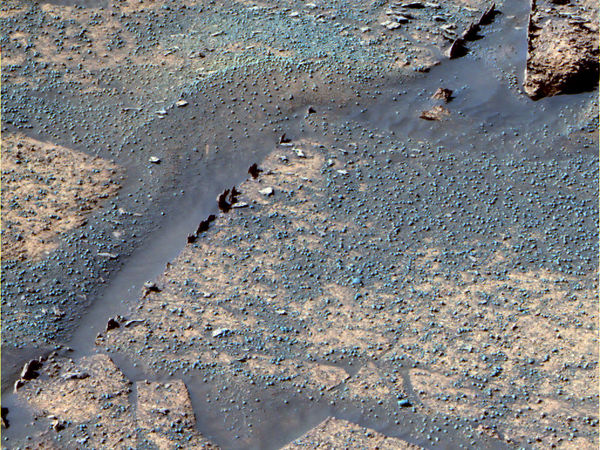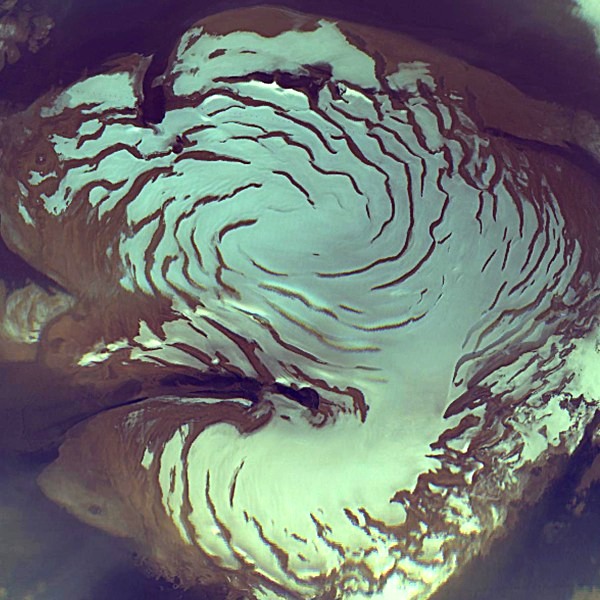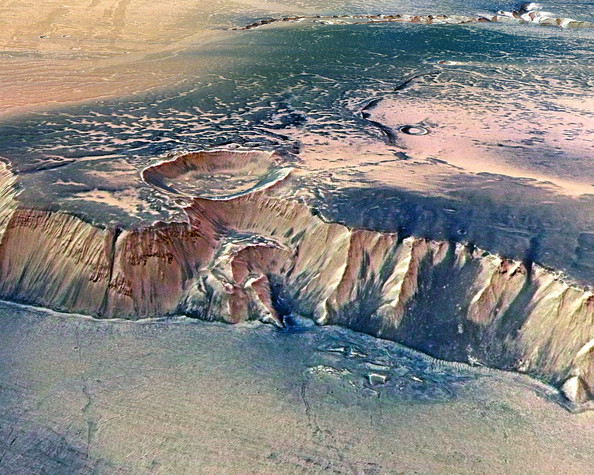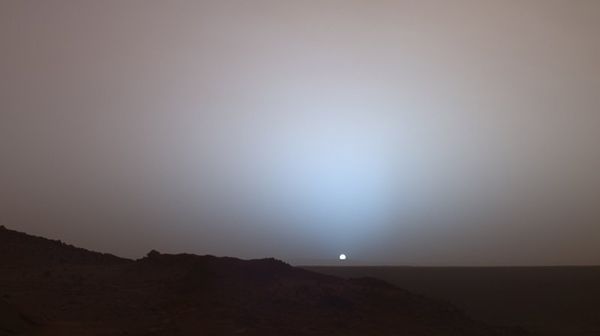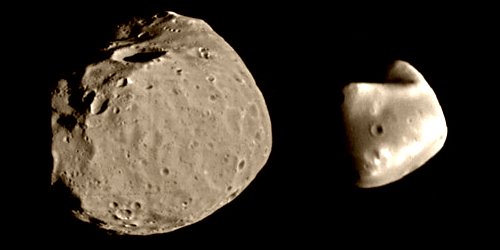Mars
Visit Mars
You can visit Mars through robotic spacecraft and interactive websites:
Mars Science Laboratory and Curiosity Rover
Mars
It took 4 days for the Apollo astronauts to travel 400,000 km to the Moon, in 1969-72. The fastest a mission to travel the 56,000,000 km to Mars took 4 1/2 months when Mars was nearest Earth. Since Earth orbits the Sun once a year, and Mars orbits in about 1.88 earth years (687 days), Mars and Earth are near one another only once every 2 years and 3 months. Astronauts on Mars would have to return quickly or plan to stay 2 years. It would be a dangerous voyage for astronauts to make, but perhaps some day they will. Mars has water, and its surface is rich in oxygen. Some of the supplies needed for a long stay are already there.
Mars' similarities to Earth
Mars is similar to Earth with hills, cliffs, dry waterways, rocks and boulders, but its surface is very old, with the oldest regions formed between 4.6 and 3.5 billion years ago. A global map of Mars made with a satellite that uses a laser to measure the height of features reveals its varied surface in ways that images in visible light cannot show. The colors in this map separate areas that are similar, and also indicate age. The bright yellow is the youngest from 3 billion years ago to present time.
Mars surface in a map from the US Geological Survey based on satellite data
Also, a Martian day is about 24 1/2 hours, and the planet's axis tilts 25° compared to Earth's 23° tilt, giving Mars seasons, albeit very cold ones. While air temperature rarely gets above freezing, sunshine easily penetrates the thin atmosphere to warm the soil. Images sensitive to infrared light (heat) show the temperature of the surface at the winter polar caps drops to -143 °C (-225 °F), but in summer the warmest soil near the equator occasionally reaches +27 °C (+81 °F)! Solar heating on Mars would be a definite possibility.
View taken by Mars Spirit Rover
Martian soil
Data from soil samples on Mars is still coming in. Some samples suggest the soil is similar to what someone might find in their backyard, with magnesium and potassium chloride, and other soluble minerals necessary for life, and traces of water. However with a pH between 8 and 9 (very alkaline) only vegetables like asparagus would grow, ruling out strawberries. There is also indication that microbial life may be able to live quite happily meters down in the soil. But, other samples taken by the Phoenix Lander in 2008 show perchlorates in the soil that could make plant growth impossible. Although it is no longer operating, scientists are still analyzing its data. Mars Science Laboratory launched in December 2011, with arrival on Mars in August 2012. It will place the Curiosity rover in Gale crater to look for conditions and evidence for microbial life.
Atmosphere about 0.7% that of Earth
Aside from being farther from the Sun, the greatest difference is that Mars is half the diameter of Earth, therefore less massive, with a little more than a third the gravity. If you weigh 120 pounds on Earth you would weigh about 46 pounds on Mars. The lower gravity holds only a thin atmosphere (about 0.7% of Earth's atmosphere) that is mostly carbon dioxide (CO2). Astronauts would require a supply of oxygen and pressurized suits to survive. Since terraforming can not be expected as a near-term solution, habitable structures on Mars would need to be constructed with pressure vessels similar to spacecraft.
The atmosphere may provide some protection from solar and cosmic radiation , gamma rays, especially since there is dust and clouds of water ice in the atmosphere.
Mars has clouds and dunes
Clouds in motion
Mars is littered with rocks, some of which look like basalt as we saw on the Moon
Mars atmosphere is not dense enough to protect from meteorites. Mars landscape is littered with what appear to be meteorites or volcanic debris.
Mars has little magnetic field to divert charged solar wind particles of protons and electrons. These would need to be deflected by thick walls or magnetic fields around buildings and space craft.
Water on Mars !!!
Warm ground temperatures also enable water beneath the surface to melt, and liquid water springs gush from the sides of craters, as seen by Mars Global Surveyor.
Water gushes from the side of a crater in Centauri Montes
Layered rock revealed along edges of craters may have been deposited by dust storms, or by water, just as layered rock occurs in Kentucky where a shallow sea once came and receded.
Victoria Crater as seen by Opportunity Rover
The edge of Victoria Cra]]ter showing rock layers
At the rim of Victoria Crater in 2007, the Opportunity Rover found more evidence of water in the past. "Blueberries" made of hematite a mineral, colored black to steel or silver-gray, brown to reddish brown, or red. It is stronger but more brittle than pure iron. Grey hematite is typically found in places where there has been standing water or mineral hot springs, such as those in Yellowstone National Park in the United States. The mineral can precipitate out of water and collect in layers at the bottom of a lake, spring, or other standing water.
Hematite from Michigan
Hematite "Blueberries" and "Razor Backs" in the bottom of Endurance Crater
Credit: Mars Exploration Rover Mission, JPL, NASA
Opportunity had seen Blueberries before, on the slopes and in the bottom of Endurance Crater in 2004. Also seen in this image it sent home are "Razor backs". These are hard minerals that are thought to have formed in cracks of surrounding softer rocks that have since eroded away, either by dust storms or water.
Opportunity started its exploration of Mars from its landing site in a small crater, then went to "stadium-sized" Endurance Crater, followed by the larger Victoria Crater which is about a km across (0.6 mi). It climbed out of Victoria in September 2008, and is making its way slowly toward Endeavor Crater, 12 km away and 22 km across (14 mi). The trip is expected to take several more monts, since it only moves 110 yards a day! Meanwhile, its twin, the little lame Spirit Rover with one bad wheel, is silent on the other side of Mars, where she explored a flat area called "Home Plate." Spirit became stuck when a wheel broke through the surface. Nature Magazine has wrote an obituary for her in January 2010. Both rovers run on solar power, and an accumulation of dust on their panels is so thick that only 25% of the sunlight reaching them gets through to make electricity. They are now programmed to take a deep sleep, and minimize power use, when not driving.
Eureka ! ("I found it", first quoted by Archimedes as he ran out of his bath when he realized how he might prove if the king's crown was made of pure gold. Archimedes then took to the streets naked, so excited by his discovery that he had forgotten to dress, crying "Eureka!" (Greek: "εὕρηκα!," meaning "I have found it!")) The most convincing evidence for water was when Phoenix Lander dug up soil, which when warmed gave off water vapor.
The low atmospheric pressure does not allow water to form on the surface. Water ice appears to be in the soil, and there are indications that beneath the CO2 ice (dry ice) polar caps is enough water ice H20, that if melted could cover the planet. Red hematite, which may form in the presence of water, is responsible for the reddish color of the soil everywhere on Mars. Perhaps some day we shall learn if Mars was once covered by a shallow sea.
North Pole on Mars is covered with both water ice and dry (carbon dioxide) ice as seen by Mars Global Surveyor
Credit: NASA/JPL/MSSS
Since Titan (a Moon of Saturn which is smaller than Mars) has a thick atmosphere, this suggests Mars once had a thicker atmosphere, that could have held onto liquid water. But if it did, it has mysteriously disappeared. Some say the carbon dioxide from the atmosphere has combined with and become trapped within carbonate rocks. On Earth, carbonate rocks release their CO2 due to weathering and plate tectonics. Oxygen from the atmosphere could also have become iron oxides, such as hemitite Fe2O3.
Although it is smaller than Mars, Saturn's Moon, Titan, has a dense atmosphere while Mars has little. This suggests Mars could once have had more air surrounding it, although colder temperatures on Titan help hold its heavy atmosphere.
Landscape
As well as being similar to Earth, with hills and dales, Mars has the deepest canyons, 5,000 km (3,000 miles) long, and many times the length and depth of the Grand Canyon on Earth. This canyon, discovered by Mariner 9 in 1971, is thought to be caused by subsidence, much like the Great Rift Valley on Earth. You can take a video tour of Valles Marineris courtesy of JPL's visualization team.
ESA Image of part of Mars' Valles Marineris Canyon, so long it would reach from New York to California.
The extinct volcano, Olympus Mons, higher than any mountain in the solar system, is three times the height of Mt Everest. Erosion along the sides of Olympus Mons are thought to be wind erosion, or perhaps Olympus Mons was once a volcanic island like the Hawaiian Islands on Earth.
Olympus Mons simulation from data
Sunset on Mars is unlike that on earth. The sky near the Sun is bluish, and the Sun is about half as wide as it appears from Earth.
Mars sunset in true colors
Now you are ready for a trip to Mars.
Satellites
Size and distance of Mars' moons Phobos and Deimos
Mars' moons, Phobos and Deimos, appear to be captured asteroids. Phobos is tiny, about 1 / 140 th the size of our Moon, but so close to Mars it appears 1/3rd as wide as our Moon as it crosses the Martian night sky in about 4 hours. Phobos is closer to its planet than any other moon. Some day it will either impact Mars or break up and become a ring of debris.
Deimos is so small and distant, it can barely be seen. It's orbit is nearly circular and may be used to determine the mass of Mars.
Mars' moons Phobos and Deimos
